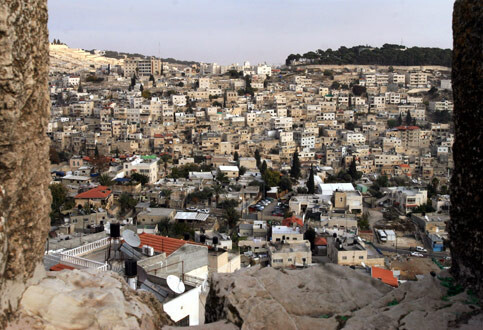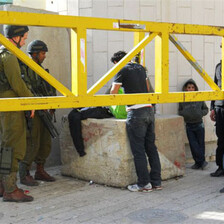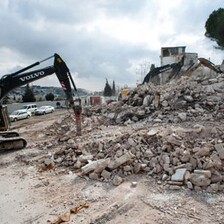The Electronic Intifada 26 November 2007

A view of the Silwan neighborhood in East Jerusalem, December 2006. (Magnus Johansson/MaanImages)
With the Golden Dome and the ancient walls of the Old City as backdrop, the cascade of Palestinian homes in the East Jerusalem neighborhood of Silwan is undergoing a dramatic transition.
At first it is hard to spot the Israeli flags draped over scattered homes on the hill, but it is soon easily apparent that right-wing Jewish settlers and politically motivated archaeologists are rushing to claim this fragment of the Holy City as the ancient City of David, complete with a visitors center and busloads of young Israeli recruits and tourists, and plaques thanking generous donors for their support.
Then there is the little-noticed news that the Israeli Parliament has given preliminary approval to a bill, in violation of international law and United Nations resolutions, which would seize East Jerusalem as a permanent part of Israel. It is thus not surprising that Secretary of State Condoleezza Rice’s belated efforts to corral reluctant world diplomats to an increasingly downgraded meeting in Annapolis are rapidly becoming mission impossible.
Every serious peace proposal addressing the creation of a two-state solution to the Israel/Palestine conflict has included the establishment of East Jerusalem as the capital of a future Palestinian state.
At the same time, often despite pronouncements to the contrary, every Israeli government since 1967 has supported the growth of a vigorous ring of settlements around Jerusalem, designed to cut off East Jerusalem Palestinians from the West Bank, and has also encouraged the intrusion of Jewish settlers into the Arab quarters of the city itself.
Why is this important? For Palestinians, when Israel annexed East Jerusalem the state declared only 12 percent of the land zoned for Palestinian residential purposes, and that land was already developed, while 34 percent was zoned for future Jewish settlements. Thus, for the 240,000 Palestinians living in East Jerusalem, there is a serious housing shortage and prices are high. This has been further complicated by construction of the eight-meter-high concrete separation wall which winds its way through the city, separating families from each other, educational institutions and employment.
The Jerusalem ID also gives Palestinians the right to work in Israel and utilize Israeli health insurance and other national benefits, as well as access to holy sites. East Jerusalem is thus a critical center for the Palestinian economy as well as political, educational and health care institutions.
Interestingly, millions of dollars of US money have been poured into the growing Jewish settlements in this area. Without any complaints from the Bush administration, real estate developers openly advertise homes in the West Bank — heavily subsidized by the Israeli government — to Jews in the United Kingdom and the United States.
A particularly egregious player in this dangerous political game is Irving Moskowitz, a US physician, bingo and gambling magnate, who secretly purchases Palestinian homes in and around East Jerusalem using front organizations that appear to be Arab, and then rapidly flips the property to extremist Jewish settlers, often arranging new construction and infusions of militant settlers at particularly sensitive political moments.
His foundation is also an avid supporter of American Friends of Ateret Cohanim, a group of militant Jews who believe that Jews should be in sole control of the Old City and should rebuild the Old Temple on the site of the Dome of the Rock and the al-Aqsa Mosque.
Moskowitz earmarks millions of dollars for militant settler religious schools most analogous to the extremist madrassas and recruitment centers often condemned in the Islamic world. These messianic, ideologically driven young Jewish students, like their counterparts in Hebron and other Jewish settlements driven by religious entitlement, are a clear impediment to any movement towards peace in this region.
It is a sad irony that the US government spends millions of dollars tracking down wealthy Arab financiers who support extremist Islamic groups. At the same time, financiers like Moskowitz, using a combination of subterfuge, bribery, and US and Israeli governmental collusion, openly and provocatively change the face of East Jerusalem.
At the end of the day, it is the facts on the ground that speak most clearly. One can only wonder what Israeli Prime Minister Olmert is thinking when he talks about a viable Palestinian state while actively making such a dream unreachable.
Perhaps a more honest name for the current madness is not the realization of the Road Map, but rather the steady creation of Road Blocks that are rapidly crushing the hopes for a viable two-state solution.
Alice Rothchild is the author of Broken Promises, Broken Dreams: Stories of Jewish and Palestinian Trauma and Resilience and cochair of Jewish Voice for Peace, Boston. This piece was originally published in The Salt Lake Tribune.





